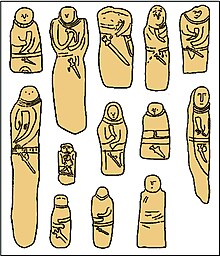Our website is made possible by displaying online advertisements to our visitors.
Please consider supporting us by disabling your ad blocker.
Scythian religion

The Scythian religion refers to the mythology, ritual practices and beliefs of the Scythian cultures, a collection of closely related ancient Iranian peoples who inhabited Central Asia and the Pontic–Caspian steppe in Eastern Europe throughout Classical Antiquity, spoke the Scythian language (itself a member of the Eastern Iranian language family), and which included the Scythians proper, the Cimmerians, the Sarmatians, the Alans, the Sindi, the Massagetae and the Saka.
The Scythian religion is assumed to have been related to the earlier Proto-Indo-Iranian religion as well as to contemporary Eastern Iranian and Ossetian traditions, and to have influenced later Slavic, Hungarian and Turkic mythologies.
- ^ redrawn from Rybakov, B. A. (1987). Язычество древней Руси [Paganism of Ancient Rus]. Moscow, Soviet Union: Nauka. p. 64. ISBN 978-5-829-11604-0.
Previous Page Next Page


